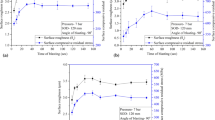Abstract
With a view to elucidating the mechanism of metal removal during the polishing and fine grinding of hard metals (case-carburized mild steel, nitrided stainless steel and a tool steel), the debris produced has been collected and examined in an electron microscope. The debris was found to consist of ribbon-like particles having a segmented structure, indicating that a chip forming process was operating. These chip-like particles have an extremely fine grain size, of the order of 10 nm diam. It is suggested that the mechanism of chip formation under the conditions examined involves i) recrystallization to a fine grain size, and ii) a plastic instability associated with this fine grain structure. The association of plastic instability with a fine grain size has far reaching implications in other deformation processes, and this is discussed briefly in relation to adiabatic shear deformation.
Similar content being viewed by others
References
L. E. Samuels: Metallographic Polishing by Mechanical Methods, 2nd ed., Pitman, London, 1971.
V. A. Phillips:Prakt. Metallogr., 1967, vol. 4, p. 637.
J. T. Black:Trans. ASME, 1971, vol. 93(B), p. 507.
S. Ramalingam and J. T. Black:Met. Trans., 1973, vol. 4, p. 1103.
L. E. Samuels:Proc. of Int. Grinding Conference, p. 283, Carnegie Press, Pittsburgh, 1972.
R. S. Hahn and R. P. Lindsay:The Science of Ceramic Machining and Surface Finishing, NBS Special Publication 348, p. 59, National Bureau of Standards, Maryland, May 1972.
E. Rabinowicz:Wear, 1971, vol. 18, p. 169.
S. K. Dean:Microtecnic, 1966, vol. 20(2), p. 1.
J. Cashion, R. L. Aghan, and E. D. Doyle:Scripta. Met., 1974, vol. 8, no. 11, p. 1261.
A. H. Morrish:Aust. Phys., Jan. 1973, p. 23.
T. J. Walker and M. C. Shaw: Proc. of 10th M.T.D.R., Sept. 1969, p. 241.
J. Friedel:Dislocations, Pergamon Press, London, 1964.
P. W. Bridgman:J. Appl. Phys., 1937, vol. 8, p. 328.
N. Gane and J. Skinner:Wear, 1973, vol. 24, p. 207.
E. D. Hondros:Interface Conference, p. 77, Butterworth and Co. (Australia) Ltd, Melbourne, 1969.
V. Ramachandran and E. P. Abrahamson:Scr. Met., 1972, vol. 6, p. 287.
P. A. Thornton and F. A. Heiser:Met. Trans., 1971, vol. 2, p. 1496.
W. E. Carrington and Marie L. V. Gayler:Proc. Roy. Soc., 1948, vol. A194, p. 323.
Author information
Authors and Affiliations
Rights and permissions
About this article
Cite this article
Doyle, E.D., Aghan, R.L. Mechanism of metal removal in the polishing and fine grinding of hard metals. Metall Trans B 6, 143–147 (1975). https://doi.org/10.1007/BF02825688
Received:
Issue Date:
DOI: https://doi.org/10.1007/BF02825688



